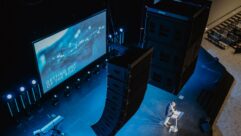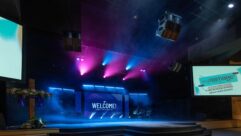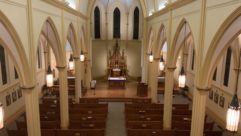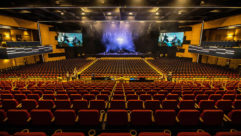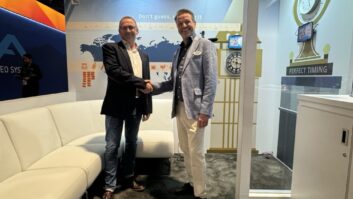
Sight Lines and Sound
Feb 13, 2014 11:07 AM,
By Cynthia Wisehart
The Michael Jackson ONE retrofit solves for both

On April 5, the Themed Entertainment Association (TEA) will present Michael Jackson ONE with a 2014 THEA Award, calling it an “electrifying achievement.” Part of that achievement is technical, including the theater retrofit and integration, the immersive scenic and content projections, and the sound system which carries Michael Jackson’s music directly to each audience member through an innovative seat audio system, a new Meyer Sound sub, and the Meyer Sound Constellation system.
On a visceral level, Michael Jackson’s artistry is about music and feet—dancing feet. So for Cirque du Soleil’s permanent attraction, Michael Jackson ONE, every seat in the house has to provide a great sonic experience—and an unobstructed view of the dancers’ feet. That’s 1,800 seats, each with an optimized experience.
The theater was a retrofit; the show was a reimagining of Cirque’s successful touring show Michael Jackson THE IMMORTAL World Tour. You can see the variables adding up here. Sound fidelity and sight lines, existing architecture, and ambitious scenic projections created layers of design that were balanced and rebalanced in collaboration among the Cirque teams, their consultants, and contractors. “Speaker locations were highly coordinated with videoscreens and rigging systems. The performers come into the aisles; there are lifts in front of the proscenium and rigging in the aisles. It was a constant layering of the different infrastructure requirements,” says Tom Neville, a principal at longtime Cirque design consultants Auerbach Pollock Friedlander. “When something didn’t work, we backed down a layer and built back up.”
Cirque’s artistic goal was immersion, not quite at the level of a theme park ride but more immersive than a typical theater experience. The projections, for example, blur the line between paint and pixels, where scenery ends and projection begins. The screens extend all the way up the sides of the theater to the first cross row, and audio is delivered to each of those 1,800 individual seats through an in-seat speaker system that is seeing its third Cirque iteration on ONE.
The theater, at Las Vegas’ Mandalay Bay, had last hosted a touring production of The Lion King—itself a groundbreaking piece of theatrical magic when it debuted in 1997, long before most of what is technically possible on ONE had even been imagined. When The Lion King moved out in 2011, an 18-month process began to change the space completely for ONE.
Auerbach Pollock Friedlander, working with Moser Architecture Studio and JaffeHolden Acoustics, reconfigured the seating and sight lines, including adjusting the rake of the lower audience bowl, increasing the rake of the parterre, and reorganizing audience circulation to avoid visual obstructions, says Len Auerbach.
In addition to consulting on the automation and rigging systems, projection booths, control rooms, wiring infrastructure, back-of-house paging, monitoring and communication, and many other aspects of the theater and show systems infrastructure, Auerbach Pollock Friedlander collaborated on the design of one of the most important audience-experience elements: the performance sound system. Principal Paul Garrity and Senior Associate Dan Mei reprised their relationship with freelance sound designer Jonathan Deans, who is responsible for the sound design on most of Cirque du Soleil’s shows and is one of the most sought-after sound designers in the world.
For the systems design process, Deans issues his sound design to Cirque’s audio team (Cirque audio technical manager Gavin Whiteley and Aaron Beck, head of audio for ONE) and to Garrity and Mei. “The Cirque audio guys know what they want; they issue equipment lists and schedules; we engineer to their systems and create drawings for the installers and the electricians, figure out wiring infrastructure, rigging, mounting details, panel face details,” Neville explains. He adds that onsite, the Auerbach Pollock Friedlander team acts as a Rosetta Stone between Cirque and the architect.
Mei says the goal of the sound design was to completely immerse the audience; Deans has described it as “wearing the sound.” This type of immediacy and personal connection had to be supported with a detailed sound system and sheer numbers of components. Imagine: There are 5,400 in-seat speakers plus another 135 mains and surrounds, plus 12 subs. The processing and distribution is equally dense. But, Neville says, the budget was not. “It was very limited,” he recalls. “There were a lot of early budget conversations and Paul [Garrity] worked hard to create a design that was within budget. Because Cirque du Soleil had the ability to reference the touring show, they knew what would be important to the permanent production. They were very successful at avoiding any moments of, ‘Oh no! We missed that.’”

On April 5, The Themed Entertainment Association (TEA) will present Michael Jackson ONE with a 2014 THEA Award, calling it an “electrifying achievement.” Among other accolades, the award singles out the immersive projection mapping (designed by Cirque’s Raymond St-Jean and Jimmy Lakatos) and of course the Pepper’s ghost illusion of Michael Jackson himself, designed by Michel Lemieux and Victor Pilon. Projection gear includes an array of Christie Roadster projectors, Daktronics LED videowall and columns, and Cirque’s go-to VYV Photon media servers controlled by a VYV controller. Although concert-style LED was initially considered, the designers went with projection, for the softer, more immersive effect. Montreal-based Fly Studio did content creation, pressing Autodesk Softimage, Adobe After Effects, Blue Newt Software, and some 20 animators into service for the video projections—which surround the audience, extend the scenery, and allow the performers to interact with projected images and virtual partners.
The performance audio system has three components: the playback and mixing system, the in-seat playback system, and a Meyer Sound Constellation system that allows the room acoustics to be electronically adjusted on the fly.
The main arrays and downfills are Meyer Sound MICA, M’elodie, and UPJ-1P speakers with JM-1Ps and MTS-4As overhead. Surrounds, subs, and frontfill are Meyer as well. The main speaker arrays are hidden behind acoustically transparent screens in the proscenium; subs and surround are on catwalks. Speakers that are over the audience are on tracks so they can be pulled to local catwalks for maintenance, Mei says. Processing is Meyer Galileo; amps are Crown. Front-of-house mixing is via a Meyer Sound CueConsole including D-Mitri processor and 120×120 matrix platform. A secondary console (Yamaha DM2000) serves for monitoring and playback.
Audio for front and back of house and monitoring is distributed via a redundant Optocore 2Gbps network with 496 inputs and 700 outputs, with matrix presets as well as on-the-fly routing capabilities. There are 16 channels of wireless microphones (Sennheiser), 16 channels of stereo in-ear monitoring, two channels of IFB, and 40 wireless receivers.
What further sets the audio system apart is the in-seat audio. Mei says it’s the third deployment of the system that was used on KÀ and The Beatles LOVE. “But you could say practice makes perfect,” he says. “We refined it this time.” While previous iterations had been built from components and installed on site, for ONE, the custom-built and self-contained three-speaker system was shipped to the seat manufacturer to be installed prior to delivery. The proprietary system was designed and built to Cirque performance criteria. The unit has three channels: “your center channel is in the seat back in front of you; the left and right come from the speaker installed in your seat back,” Mei explains. “Each seat arrived with a jumper cable on it that is connected in a 70V parallel loop with a home run at the end of each row. Each row was it’s own loop.” The rows were then grouped into zones with four or five rows to a zone, 24 zones total so that delay and EQ could be customized by zone, as could effects such as crowd noise or motion effects. “Jonathan could send different effects to different parts of the theater.”
Mei says that while in the previous installations they used screw terminals (and faced issues of polarity), this time they used Molex connectors in order to connect from seat to seat. “We took what he had learned about installation and wiring and were able to detail it on the drawings in a very exact way. We even specified down to the Wago terminal blocks needed and how they should be mounted in junction boxes,” Mei says.
In addition to the performance system, which Mei and Garrity designed in close collaboration with the Cirque team, they also took full responsibility for design of the elaborate back-of-house communication network, including paging and a production video network of Panasonic PTZ cameras and headend to allow for monitoring of the performers.
Racks and installation were from the Montreal-based Solotech, out of its Las Vegas office under Bob Barbagallo. Mei says the local electrical contractor, G&G Electric, also supplied quality work. “The installation went really, really smoothly. When I got there for checkout, we were able to check everything in a day, maybe a day and a half,” Mei recalls with a certain amount of gratitude.



